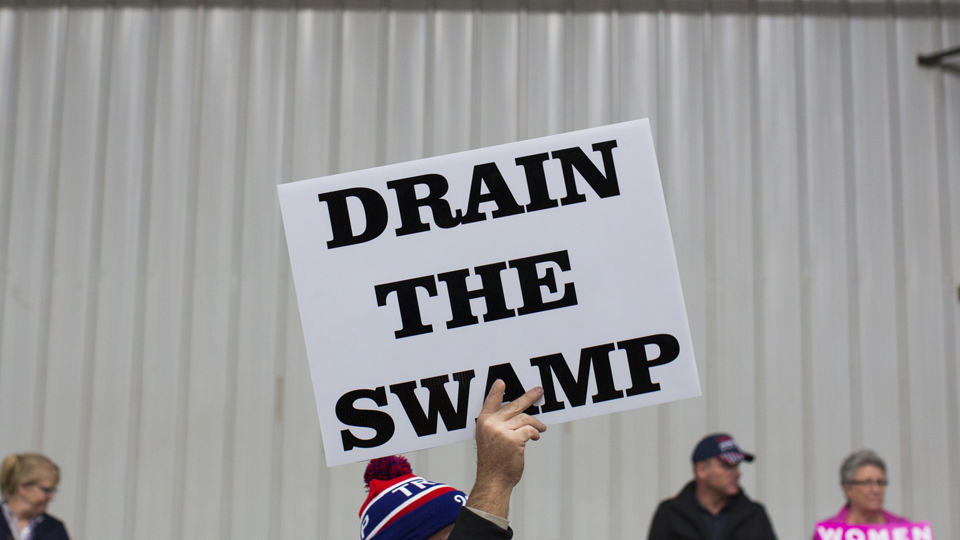
Donald Trump famously promised to “drain the swamp” in Washington D.C., as a metaphor for corruption in the nation’s capital led by the first Black president. It was also a color-coded insinuation that President Barack Obama, by most accounts one of the most transparent and ethical presidents in our age, and the administration he led, were corrupt.
Trump’s “drain the swamp” also fits well with his and his party’s vicious “jail Hillary” campaign slogan and their long-standing avatar of “tax-and-spend Democrats,” which is accompanied by attacks on programs that help people, including brown and black people.
At its heart, the “drain the swamp” narrative was a noxious mix of racism and misogyny designed to cover-up the years of Republican obstruction and destruction in Congress, which resulted in government shut down, a stolen Supreme Court nominee and frustrating any meaningful progressive reform, such as immigration, pay equity, raising the minimum wage and environmental protection. Instead, the phrase set Trump up as the populist strongman, who can get things done and clean up the mess left by those Washington elites, especially, as the logic of racist coding goes, that “elite” man in the White House.
(Elite is a favorite noun and adjective of Fox News, not to highlight class divisions and interests, but to obfuscate them by painting every politician and institution with that descriptor, regardless of their role in upholding democratic rights and norms. It also can hold a racially-coded meaning as well.)
As Trump began to announce his Cabinet and White House picks, it became clear to millions, especially the more than 65 million who gave Clinton a popular vote victory, that he had no intention to clean up any corruption in D.C. as he populated his top posts with billionaires, generals, haters and ignoramuses (Rick Perry as Energy secretary comes to mind). One commenter, responding to a New York Times article on Trump’s picks, summed it up succinctly when she wrote, “I didn’t realize that when Trump said he was going to drain the swamp, what he meant was that he would take all the poisonous reptiles he finds and put them in his Cabinet.”
And with their attempt to jettison key rules and investigative powers for the independent Office of Congressional Ethics, the GOP-led House of Representatives had hoped to let those reptiles roam without restraint in the halls of Congress. But they were met with a firestorm of criticism from Democrats and good government groups. Because of the sheer hypocrisy of it all, even Trump tweeted his rather tame criticism of the move, which former Obama adviser David Axelrod called “a gift” for the president-elect. It was “a big fat zeppelin for him to shoot down.”
But what the ethics drama showed is that victories can be won during the upcoming battle around Trump’s reptilian appointments. The Washington Post reported that the Senate Democrats plan to fight eight of Trump’s proposed Cabinet appointments.
Senate Minority Leader Charles Schumer of New York said Trump was trying to seat a “rigged Cabinet” of nominees who “have made billions off the industries they’d be tasked with regulating.”
Number one on their list is the proposed secretary of state, Rex Tillerson, who embodies why peace movements use the slogan, “No war for oil.” But the CEO of Exxon-Mobil, like Trump and his tax secrets, told the Senate Foreign Relations Committee that he would only provide “tax return information” for himself and his wife for the previous three years, hobbling a thorough ethics review.
Other Trump picks on the Democrats’ list are: Sen. Jeff Sessions, R-Ala., for attorney general; Rep. Mick Mulvaney, R-S.C., to head Office of Management and Budget; Betsy DeVos, for education secretary; Rep. Tom Price, R-Ga., for Health and Human Services; fast food magnate Andrew Puzder, for labor secretary; Steve Mnuchin, as treasury secretary, and Oklahoma Attorney General Scott Pruitt, for the Environmental Protection Agency.
Nobel prize winner and columnist Paul Krugman, in describing the nature of the incoming Trump administration, pointed to the monumental conflict of interest the president-elect has with his global businesses, including violating “the spirit, and arguably the letter of, Constitution’s emoluments clause, which bars gifts or profits from foreign leaders, as soon as he recites the oath of office.”
Like a kleptocracy, which is a government dominated by corrupt officials who seek to use the levers of power to enrich themselves and amass more political power, Krugman forecasts that the corruption will be throughout the administration, turning the country into a “-stan.” Those are the Central Asian states, like Turkmenistan, that became independent nations after the collapse of the Soviet Union, ruled by “strongmen who surround themselves with tiny cliques of wealthy crony capitalists,” wrote Krugman. “Everything we know suggests that we’re entering an era of epic corruption and contempt for the rule of law, with no restraint whatsoever.”
Trump’s version of “draining the swamp” means getting rid of democratic norms, government programs like Obamacare, Social Security, Medicaid and Medicare, and environmental, labor and civil rights regulations on corporate power. In this sense, Trump, like the ruthless real estate developer that he is, is not going to end corruption but pave over a fragile eco-system and fill it with fortress-like temples to honor, as Pope Francis once said, “god of money, and not the person.”
And speaking of eco-systems, swamps have gotten a bad rap. They are actually “the most valuable ecosystems on Earth.” Among their many critical roles, they absorb excess water thereby helping to prevent floods; they filter the chemicals and fertilizers that get into water systems thereby helping to purify water. That is probably why swamps are called wetlands now, a word with less sinister baggage, more environmental value.
According to National Geographic, swamps were routinely drained and filled with concrete and other man-made materials. “Almost half of U.S. wetlands were destroyed before environmental protections were enacted during the 1970s.”
Those environmental protections came from the massive environmental movement protesting Love Canal, acid rain, massive oil spills and other ecological disasters. Some 20 million people rallied on April 22, 1970, to protest. Richard Nixon was forced to respond, and through executive order, proposed the establishment of the EPA. April 22 is now recognized as Earth Day.
That may serve as a lesson for what it will take to tie the hands of the pickpockets ready to assume power on Jan. 20. Perhaps it is time to see the swamp, not as a metaphor for corruption, but as a vital piece in the ecology of democracy and role of government.










